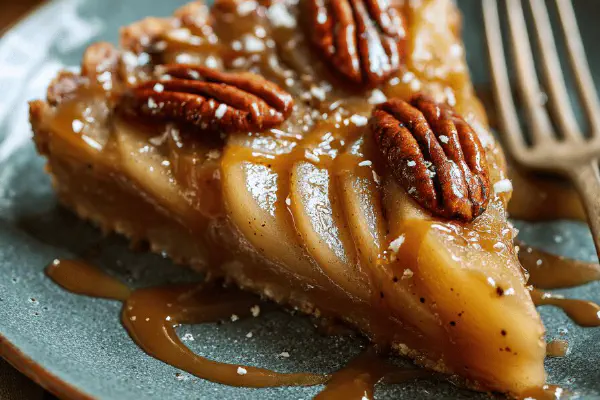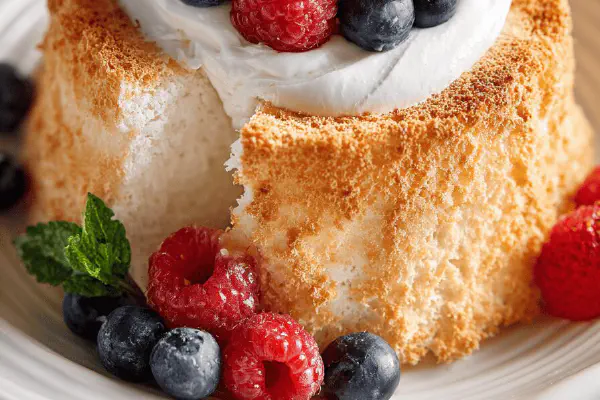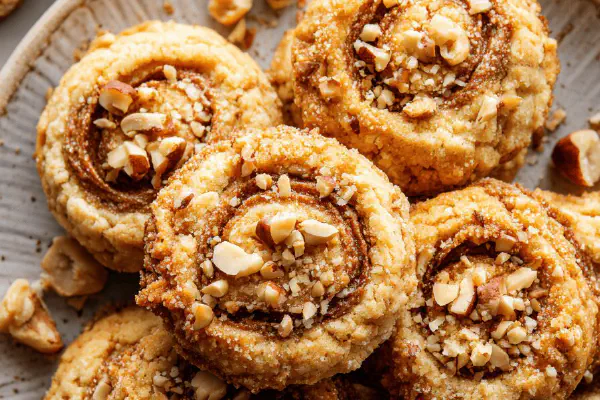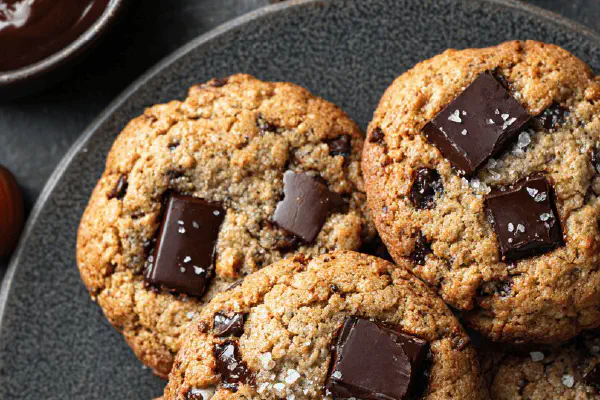Featured Recipe
Vegan Caramel Brioches
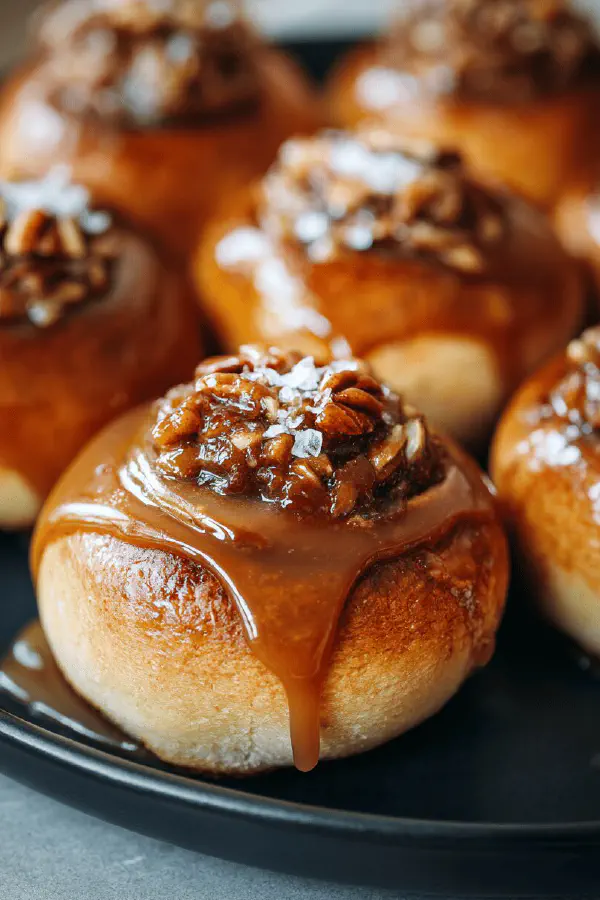
By Kate
"
Caramel-filled vegan brioches using coconut milk and oil. Yeast dough rested overnight, rolled with spiced maple-caramel filling. Baked until golden, then inverted onto a board. Slightly tweaked quantities and added maple syrup twist. Dairy-, nut-, egg-free. Soft, sticky texture with cinnamon aroma. Total bake time about 40 minutes, rise time adjusted. Twelve buns from one batch. Simple ingredients, primarily flour, sugar, yeast, spices, and coconut oil.
"
Prep:
40 min
Cook:
40 min
Total:
Serves:
12 servings
vegan
baking
dessert
caramel
French
Introduction
Yeast bubbling in warm water. Flour floats. Coconut milk smooth, thick. Oil soft and sweet. Brown sugar sticky, cinnamon sharp. Maple syrup slow drizzle. Combine. Chill overnight, dough rests stiff and mellow. Roll out flat, spread caramel layer thick, roll tight, cut neat. Warm rise drapes buns into velvet balloons. Oven heat draws crust golden, caramel pools sticky sweet. Flip to tumble, buns tumble out onto board. Soft, spiced, vegan comfort. Twelve times over, sharing tight tight bites. Simple pantry, no eggs, no dairy, no nuts. Just sweet earthy warmth and a mess of caramel hugs.
Ingredients
Dough
- 70 ml warm water (just over 1/4 cup)
- 6 ml instant yeast (1 1/4 tsp)
- 420 g unbleached all-purpose flour (3 cups)
- 65 g sugar (1/3 cup)
- 6 ml salt (1 1/4 tsp)
- 1 can (398 ml) light coconut milk
- 4 ml vanilla extract (slightly less than 1 tsp)
- 100 g virgin coconut oil, softened (slightly less than 1/2 cup)
- 35 ml virgin coconut oil, melted (2 1/3 tbsp), plus extra for brushing
- 220 g brown sugar (7/8 cup)
- 140 ml maple syrup (just under 2/3 cup)
- 3 ml ground cinnamon (3/4 tsp)
Filling
About the ingredients
Warming water needs to be tepid or lukewarm - not hot or yeast dies. Instant yeast preferred for speed and consistency. Flour measured by weight for baking precision; spoon and level if using volume. Virgin coconut oil adds fragrance and softness, softened not melted in dough. Light coconut milk keeps texture airy but moisture rich. Maple syrup replaces part of sweet for nuanced caramel notes. Brown sugar chosen for deep molasses flavor, blend with cinnamon sharpness. Measure spices carefully to avoid overpowering. Extra oil for baking pan prevents sticking and adds crisp edges.
Method
Dough preparation
- 1. Mix warm water with yeast in small bowl. Let sit 6 minutes to dissolve.
- 2. In mixer bowl fitted with dough hook, combine 375 g flour, sugar, salt. Add yeast mix, coconut milk, vanilla. Stir until combined.
- 3. Add softened coconut oil. Mix 6 minutes until dough smooth. Add remaining flour (45 g) to help emulsify. Cover with plastic wrap. Refrigerate 7 hours or overnight.
- 4. Lightly grease 33x23 cm (13x9 in) baking dish with melted coconut oil.
- 5. Mix filling ingredients in bowl until uniform.
- 6. Flour work surface lightly. Roll dough into 33 cm square about 1 cm thick.
- 7. Spread filling evenly, leaving edges bare. Roll tightly into log. Slice 12 rounds.
- 8. Arrange slices cut side up in pan. Cover with damp cloth or plastic wrap. Let rise 40 min in warm, humid spot until doubled.
- 9. Preheat oven to 175°C (350°F). Rack in middle.
- 10. Bake brioches 40 min until golden brown. Insert thin blade between pan and buns.
- 11. Place board or plate top of pan. Invert gently to release buns onto board.
- 12. Remove pan carefully. Cool buns 15 min before eating.
Filling and assembly
Baking and finishing
Technique Tips
Yeast activation is quick but vital—wait until frothy bubbles. Dough may be sticky but tacky surface is normal. Mixing times vary with mixer power; watch for smooth homogenous dough. Overnight rest allows gluten to develop slowly, flavor deepens. Roll dough evenly to avoid uneven rise, dust surface gently with flour to prevent sticking. Spread filling carefully, don’t overload or rolling gets awkward. Rising environment warm but not hot, moist atmosphere aids rise. Baking at moderate heat ensures full cook without drying. Inverting hot pan requires patience—loosen sides first with thin blade. Cooling brief, buns best warm but not hot.
Chef's Notes
- 💡 Monitor yeast closely. Water should be warm—taps, one-fourth cup. Not too hot or too cold. Frothing after 6 minutes means success. If not, start again.
- 💡 Flour measurements matter. Use a scale. 420 grams is specific. This won't work if you're spooning and leveling. Too much flour, buns won't rise.
- 💡 Dough will be sticky. Tacky is okay. A little extra flour when rolling out helps. Don't overload the filling. Even distribution is key for even slices.
- 💡 Rising time is crucial. Cover with a damp cloth. Warm, humid area is best. Don’t rush. If it's cool, buns will end up dense. Try an oven on warm.
- 💡 Baking temperature is important. Moderate heat—175°C is perfect for golden color. Check about 30 min in. If browning quickly, cover lightly with foil to prevent burning.
Kitchen Wisdom
Can I make these ahead a day?
Yes, overnight rest is awesome. Keep in fridge. Bake the next day. Just take out, let rise then bake.
What if dough feels too wet?
Don’t panic. Add a bit more flour. But consider humidity. Flour absorbs differently. Adjust as needed.
Can I substitute coconut milk?
Yes, but results vary. Almond, soy, oat milk work. Coconut gives moisture, flavor. May not mimic exactly.
How to store leftovers?
Room temp is fine for a day. Refrigerate for freshness longer. Reheat in oven for soft texture. Not the microwave.
